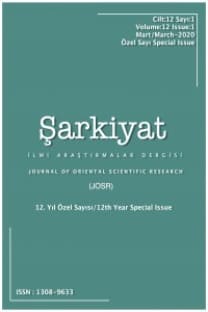MEHMED MUSÎB EFENDİ VE “TUHFETÜ’L-İRFÂN” ADLI ESERİ
Klasik Türk edebiyatı tarihini ilgilendiren el yazması Osmanlıca eserler, dünyanın neredeyse tüm yazma eser kütüphanelerine yayılmış hâldedir. Geçmişimize ayna olan bu el yazması eserlerin hala birçoğu tespit edilemediği gibi haklarında yeterli incelemeler de yapılamamaktadır. Tarafımızca tespit edilen Farsça-Türkçe manzum sözlük şerhi türündeki Tuhfetü’l-İrfân bu eserlerden biridir. Hakkında herhangi bir bilimsel çalışma bulunmayan bu eser, 18. yüzyıl divan şairi Kıbrıslı Mehmed Musîb Efendi tarafından yazılmıştır. Eser, Mevlânâ’nın Mesnevî’sinin daha iyi kavranabilmesi için yazılmış Tuhfe-i Şâhidî’nin ilk 14 beytinin şerhini içermektedir. Şerhte, beyitlerin vezin ve taktileri gösterilip, kelimelerin Türkçe, Arapça ve Farsça şekilleri ve anlamları verilmiştir. El yazması eserin, başka bir nüshasına rastlanılmamış olup müellif hattı olduğu düşünülmektedir. Mehmed Musîb Efendi (ö. 1754-55) ve Tuhfetü’l-İrfân adlı eseri hakkında yapılan araştırma ve taramalarda herhangi bir bilimsel çalışmanın yapılmadığı ve tespit edilen bu eserin, Tuhfe-i Şâhidî üzerine yapılmış çalışmalarda zikredilmediği fark edilmiştir.
Bu çalışmayla, adının geçtiği tezkirelerde hakkında çok az bilgiler verilen Musîb ile kaynaklarda ismi zikredilmeyen ve bir Tuhfe-i Şâhidî şerhi olan Tuhfetü’l-İrfân adlı eserinin tanıtımı amaçlanmıştır.
Anahtar Kelimeler:
Musîb Efendi, Tuhfetü’l-İrfân, Tuhfe-i Şâhidî, Şerh, El Yazma.
MEHMED MUSIB EFENDI AND HIS “TUHFET-AL IRFÂN”
Ottoman manuscripts concerning the history of classical Turkish literature are spread to almost all manuscript libraries globally. Many of these manuscripts, which mirror our past, are still not identified and cannot be examined adequately. Tuhfet-al Irfân, a Persian-Turkish verse lexicon commentary determined by us, is one of these manuscripts. This manuscript, on which there are no scientific studies, was written by the 18th-century divan poet Cypriot Mehmed Musib Efendi. The manuscript contains the commentary of the first 14 couplets of Tuhfe-i Şahidi, written for embracing of Mawlana’s Mathnawi. In the commentary, the verses and tactics of couplets are shown, and the Turkish, Arabic and Persian forms and meanings of the words are given. No other copy of the manuscript has been found, and it is thought that it may be the handwritten form of the author. It was noticed that no scientific study was conducted in the researches and surveys about his work named Mehmed Musib Efendi (d. 1754-55) and his work named Tuhfet-al-Irfân, as well, this work was not mentioned in studies on Tuhfe-i Şahidi.
This study aims to introduce Musib, whose name is given very little information in the collection of biographies, and his Tuhfet-al Irfân, which is a commentary of Tuhfe-i Şâhidî, whose name is not mentioned in the sources.
Keywords:
Musib Efendi, Tuhfet-al Irfan, Tuhfe-i Şahidi, Commentary, Manuscript.,
___
- Referans1 Amerika New York Columbia Üniversitesi Nadir Kitaplar ve El Yazmaları Kütüphanesi David Eugene Smith Koleksiyonu Ms. Or. 385
- Referans2 Yusuf Öz, Tuhfe-i Şâhidî Şerhleri. Konya: Selçuk Üniversitesi Fen-Edebiyat Fakültesi Yayınları, 1999.
- Başlangıç: 2009
- Yayıncı: Şarkiyat Araştırmaları Derneği
Sayıdaki Diğer Makaleler
ŞEYH ÂZERÎ’NİN FARSÇA URÛCİYYE’Sİ VE TÜRK EDEBİYATINDAKİ DEVRİYYELER İLE KISA BİR MUKAYESESİ
9/11 SONRASI AMERİKAN ROMANINDA KORKU ÜRETİM
M Ikbal M ALOSMAN, Raihanah M. M, Ruzy Suliza HASHİM
AHMED HÂLİD TEVFÎK’İN ÜTOPYA ADLI ROMANINDA MISIR TOPLUMSAL HAYATININ DİSTOPİK YORUMU
ARAP EDEBİYATI BAĞLAMINDA İBRAHİM SÛRESİNİN 37. ÂYETİ
E- AŞİRET: AŞİRET KİMLİĞİNİN SOSYAL MEDYADA YENİDEN ÜRETİMİ FACEBOOK ÖRNEĞİ
TEFSİR'DE ÇEŞİTLİLİK (TENEVVÜ‘) BAĞLAMINDA MÜ’MİN 60 VE FURKÂN 77. AYETLERİN YORUMU
FIKHÎ İHTİLAFLARA ETKİSİ BAKIMINDAN ÂM LAFIZLARIN DELÂLETİ
Feqê Qadirî Hemewend in the Ottoman archives
